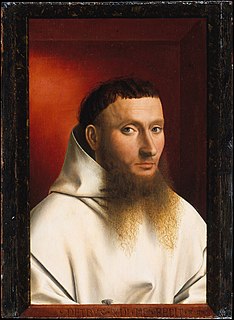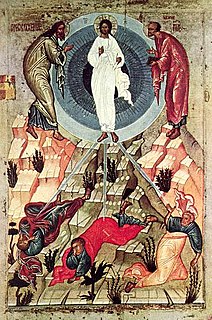
Anthony the Great, was a Christian monk from Egypt, revered since his death as a saint. He is distinguished from other saints named Anthony, such as Anthony of Padua, by various epithets: Anthony of Egypt, Anthony the Abbot, Anthony of the Desert, Anthony the Anchorite, Anthony the Hermit, and Anthony of Thebes. For his importance among the Desert Fathers and to all later Christian monasticism, he is also known as the Father of All Monks. His feast day is celebrated on 17 January among the Orthodox and Catholic churches and on Tobi 22 in the Coptic calendar.

John Climacus, also known as John of the Ladder, John Scholasticus and John Sinaites, was a 6th–7th-century Christian monk at the monastery on Mount Sinai. He is revered as a saint by the Latin Catholic, Eastern Orthodox and Eastern Catholic churches.

A monastery is a building or complex of buildings comprising the domestic quarters and workplaces of monastics, monks or nuns, whether living in communities or alone (hermits). A monastery generally includes a place reserved for prayer which may be a chapel, church, or temple, and may also serve as an oratory, or in the case of communities anything from a single building housing only one senior and two or three junior monks or nuns, to vast complexes and estates housing tens or hundreds. A monastery complex typically comprises a number of buildings which include a church, dormitory, cloister, refectory, library, balneary and infirmary, and outlying granges. Depending on the location, the monastic order and the occupation of its inhabitants, the complex may also include a wide range of buildings that facilitate self-sufficiency and service to the community. These may include a hospice, a school, and a range of agricultural and manufacturing buildings such as a barn, a forge, or a brewery.

Mount Athos is a mountain and peninsula in northeastern Greece and an important centre of Eastern Orthodox monasticism. It is governed as an autonomous polity within the Hellenic Republic, namely the monastic community of Mount Athos under the direct jurisdiction of the Ecumenical Patriarch of Constantinople.

Severus the Great of Antioch, also known as Severus of Gaza, was the Patriarch of Antioch, and head of the Syriac Orthodox Church, from 512 until his death in 538. He is venerated as a saint in the Oriental Orthodox Church, and his feast day is 8 February.

A monk is a person who practices religious asceticism by monastic living, either alone or with any number of other monks. A monk may be a person who decides to dedicate their life to serving other people and serving God, or to be an ascetic who voluntarily chooses to leave mainstream society and live their life in prayer and contemplation. The concept is ancient and can be seen in many religions and in philosophy.

Saint Macarius of Alexandria was a monk in the Nitrian Desert. He was a slightly younger contemporary of Macarius of Egypt, and is thus also known as Macarius the Younger.

Christian monasticism is the devotional practice of Christians who live ascetic and typically cloistered lives that are dedicated to Christian worship. It began to develop early in the history of the Christian Church, modeled upon scriptural examples and ideals, including those in the Old Testament, but not mandated as an institution in the scriptures. It has come to be regulated by religious rules and, in modern times, the Canon law of the respective Christian denominations that have forms of monastic living. Those living the monastic life are known by the generic terms monks (men) and nuns (women). The word monk originated from the Greek μοναχός, itself from μόνος meaning 'alone'.

Basilian monks are Catholic monks who follow the rule of Basil the Great, bishop of Caesarea (330–379). The term Basilian is typically used only in the Catholic Church to distinguish Greek Catholic monks from other forms of monastic life in the Catholic Church. In the Eastern Orthodox Church, as all monks follow the Rule of Saint Basil, they do not distinguish themselves as "Basilian".

Sumela Monastery is a Greek Orthodox monastery dedicated to the Theotokos located at Karadağ within the Pontic Mountains, in the Maçka district of Trabzon Province in modern Turkey.

February 18 - Eastern Orthodox liturgical calendar - February 20

Eastern Christian Monasticism is the life followed by monks and nuns of the Eastern Orthodox Church, Oriental Orthodoxy, the Church of the East and Eastern Catholicism. Eastern monasticism is founded on the Rule of St Basil and is sometimes thus referred to as Basilian.

Joannicius the Great was a Byzantine Christian saint, sage, theologian and prophet. Well known for his devoted asceticism and defense of icon veneration, Joannicius spent the majority of his life as a hermit on Mysian Olympus, near what is today Bursa, Turkey. Joannicius lived during the reign of Emperor Theophilos, a noted iconoclast, which contrasted with Joannicius's embrace of icon veneration. Icon veneration was later restored to the Byzantine Empire under the reign of Empress Theodora, a move that some devotees ascribe to Joannicius's influence and prophecies. Joannicius served in the Byzantine army in his early years before devoting his life to ascetic study and monastic contemplation. He is venerated with a feast day on November 4 in the Eastern Orthodox Church and Roman Catholic Church.

Chariton the Confessor was a Christian saint. His remembrance day is September 28.

Saint Pishoy, known in the Coptic Orthodox Church of Alexandria as the Star of the Desert and the Beloved of our Good Savior, was a Coptic Desert Father. He is said to have seen Jesus, and been bodily preserved to the present day via incorruptibility at the Monastery of Saint Pishoy in the Nitrian Desert, Egypt. He is venerated by the Oriental Orthodox Churches and the Eastern Orthodox Churches, and is known in the latter under the Greek version of his name, Paisios.
Saint Matthew the Hermit was a 4th-century Christian priest. He is venerated as a saint in the Oriental Orthodox Church and his feast day is 18 September.
Athanasius I Gammolo was the Patriarch of Antioch and head of the Syriac Orthodox Church from 594/595 or 603 until his death in 631. He is commemorated as a saint by the Syriac Orthodox Church in the Martyrology of Rabban Sliba, and his feast day is 3 January.
John XII Yeshu was the Patriarch of Antioch, and head of the Syriac Orthodox Church from 1208 until his death in 1220.

Saint Paul of Xeropotamou, also Saint Paul of Xiropotamos or Saint Paul of Xeropotamos, was a Byzantine ascetic, lived between the 9th and the 10th century on Mount Athos, where he also restored and founded monasteries. He is commemorated in the Orthodox Church and his feast day is on 28 July.

This article lists historical events that occurred between 401–500 in modern-day Lebanon or regarding its people.